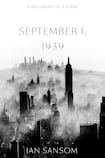
Sitting in a bar on 52nd Street, WH Auden read in the “folded lie” of a newspaper about the accession of Danzig to the Third Reich. The poem he would write about the events of that night is the subject of Ian Sansom’s September 1, 1939: A biography of a poem (Fourth Estate, £16.99). Sansom wrote his PhD on WH Auden 25 years ago and, as he finally assembles his notes from those studies and 25 subsequent years of reading in the vicinity of Auden, he has understandably mixed feelings about the poem.
Entertaining, insightful, partial, digressive, the “biography” is at least as revealing about Sansom as the poem itself. He moves to Northern Ireland, begins to publish detective fiction, his children are born, grow up and leave home, and still he reads and rereads the poem, all the while accumulating more material, not just from new biographies and critical work but from Sansom’s interests in seemingly unrelated materials, so that we learn about Auden and detective fiction, Auden and teaching, Auden and “odour”.
He is gossipy about some of Auden’s habits, and can be good at winkling out telling meanings from stock words or phrases, noticing the American format of the title’s date (not 1 September, 1939). He is excellent on how Auden’s own omnivorous reading surfaces in the poem, and swivels from how a phrase like “the whole offense” might refer to Auden’s experience of Germany as “a site of fantasy and fulfilment” to how Auden uses Nijinsky’s break-up with Diaghilev to dramatise the conflict between love and power: “each woman and man / craves what it cannot have, / not universal love / but to be loved alone.”
Reading his account of reading the poem is like a year-by-year equivalent of a “minute-by-minute” report on a sporting event. And he wears his decades’ learning lightly, acknowledging and drawing on Auden’s best critics, but clearly not playing their game: “Writing about Auden after John Fuller and Edward Mendelson is”, he writes, “like playing tennis after Federer and Nadal.”
The crux of the book is Auden’s desire to write poems which could include the momentous events of his time, without shifting into sentimentality or rhetoric. September 1, 1939 is one of a clutch which yoke together intensely private experiences with overwhelmingly significant public, political events. Sansom distrusts these poems’ ambitions, even while he relishes the sheer excitement of how inventively they are put together.
Rhetorical clincher
The cue for Sansom’s distrust is, of course, Auden’s decision to reject and exclude this poem from his later Selected and Collected Poems (volumes from which it remains absent). Auden’s issue was with a single line which he felt was not honest, the famous rhetorical clincher: “we must love one another or die.”
For a line, for a poem, to achieve such durable power rarely happens, particularly when its author rejects it. Auden’s obvious template was WB Yeats’s Easter 1916 (did Yeats ever regret declaring “A terrible beauty is born”?), but his tone is very different to Yeats’s, something announced by its setting, not in a tower, or a club, or a drawing room, or even a museum, but in that mid-town dive bar, whose raffishness Sansom is very good on. Its lowdown setting may be the reason it became a defining poem of the sociable modern city it was written in, and eventually, as Samson documents, an integral part of the city’s response to 9/11. It is maybe the power of that setting which sways the poem away from, or somehow counterbalances its rhetoric for the contemporary reader.
In his consideration of the poem’s many contexts, some of Sansom’s digressions are remarkable, such as a note on Auden’s feelings after making a “a fighting demagogic speech” at a fundraiser (“it is so exciting but so absolutely degrading”), which Sansom links to a quotation from Victor Klemperer about language in Nazi Germany: “Words can be like tiny doses of arsenic: they are swallowed unnoticed, appear to have no effect, and then after a little time the toxic reaction sets in after all.” Other digressions trail away into loose ends or patchwork together quotations, not just from other writers but from Sansom’s own back catalogue of reviews. The book then betrays its extended period of composition, and leads to unnecessarily niggly coat-trailing when he critically quotes Seamus Heaney’s “summation of Auden’s achievement as a ‘writer of perfect light verse’”, without acknowledging Heaney’s subsequent description of this as a misrepresentation of his response to Auden.
Critics usually aspire to having the second-last word and Sansom’s enjoyable book will send its curious readers back to Auden. His self-reflexive “biography of a poem” is part of a recent phenomenon: like Maureen N McLane’s My Poets, Megan Marshall’s biography of Elizabeth Bishop, and Don Paterson’s books about reading Shakespeare and Michael Donaghy, Sansom’s book happily reminds readers that poetry has ambitions for the general reader. He also makes a practical point: the layers of notes and criticisms offer reassuring evidence that imperfections do not make a great poem less great, and may indeed be a necessary part of how, as we approach yet another political Rubicon, some great poems’ “ironic points of light / flash out wherever the Just / exchange their messages”.










